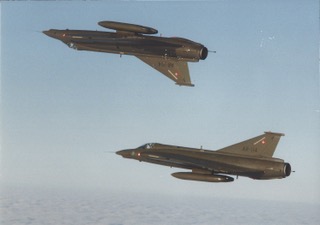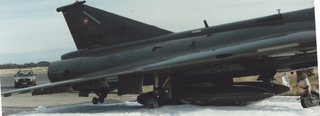I flew the Danish F-35 Draken
Dirk Reid swapped his RAF Tornado for a Saab Draken in the Royal Danish Air Force. Here he describes the excitement and idiosyncrasies of the fabulous F-35 Delta Dragon.
“It was a single-seat, single-engined aircraft, yet went for 13 years without any hull loss – compare that with Jaguars, Harriers and F-104s.

Draken in three words..
Quirky, innovative, versatile
What was the best thing about the Draken? Adaptability – our roles included recce, anti-shipping, EW, air-ground, other versions were capable air defenders in their time. And the radio, which had hundreds of pre-studded frequencies – just rotate one knob to find the airbase, then press the button marked ‘Radar’ for the radar frequency, the one marked ’Tower’ for the tower frequency etc etc
..and the worst? Being a double delta, it’s low-speed handling. In a stall, the rear section of the wing would lose lift first, whilst the forward part would continue flying, hence the nose came up. Then the forward part lost lift, so the nose would drop, until increased speed caused it (but not the rear part) to fly again, so the nose came up again….. This was called a super-stall, recovery required the stick to be pushed forwards as the nose came down, until both parts of the wing were creating lift, and then pulling out of the subsequent dive – if you had 10,000 ft to play with. Hence the front of the stick was fitted with the ‘knife’, a narrow blade of metal that, when the AoA, or onset of AoA was too high, rapidly vibrated against the pilots fingers causing a natural immediate releasing of the stick. Also, the fuel-state indications in the cockpit, which led directly to the first hull loss for many years. The SAAB designers were very good at taking human qualities into account when developing the aircraft, but this was a rare lapse.

What is the biggest myth about the aircraft? It’s short-field capability. Despite the parachute, landing at Rønne, Bornholm, which was 6,500ft long, needed you to get it on the numbers.
What was your first flight like? Such a long time ago! Thoroughly enjoyable I recall, but a blur of activity with plenty of fuel checks – I was used to turbofans, not a turbojet!

What was your most memorable experience flying the Draken? Probably the long-range recce missions into the far east of the Baltic. We’d launch from Karup and do a training mission on our way to Rønne, where a very lean support operation would give us fuel and a fresh parachute, which we’d have to re-fit into the aircraft. The recce from there was usually a hi-lo-hi profile, with a pair of F-16s as top cover to provide radio relay. We’d do as much as we could before pulling out on fuel minimums for the cruise home with the film for the eagerly-awaiting Photo Interpreters. If we got low on fuel, it was hard to resist the temptation to slow down, which had worked very well on my previous aircraft, but the double delta produced a max range speed of 450kts at low-level or 0.87M at height!
What was the role of the Draken and in which unit did you fly? It had many roles, but 729 Sqn was primarily a recce and anti-shipping outfit. We did a lot of ship recce in the Baltic, the cameras could be mounted to face forwards, sideways, down and rearwards, there was even a 42 inch sideways-facing lens that was very useful for peering deep inland. In the anti-shipping role we weren’t equipped with any guided missiles, so weren’t blue-water capable, more using rockets, bombs and bullets for opposing landing forces.

A. Instantaneous turn rates
Excellent for it’s generation, but no match for an F-16
Sustained turn Needed the burners in! Incidentally, I was used to the Tornado, where the engine ran at max dry and the reheat was varied by the throttle once ‘through the gate’. In the Draken, the burner was on/off, and the engine speed was varied with the throttle
C. Climb rate Good for a mud-mover, but not equal to the fighter versions – we generally carried a lot under our wings.
D. General agility Not brilliant once the speed came off and the double delta started inducing drag.
E. High angle of attack performance See reference to the super stall above
F. Off-base operations Bread and butter to the Swedes, and designed into the airframe, but we never practised it.
G. As a fighter No radar in our version! We practised ACT and did well in a visual fight against older aircraft.
H. Sensors Day VFR only – we had a HUD for weapon aiming and a radalt and a laser to get the data into the weapon-aiming system – all our ordnance required visual acquisition of the target. Ironically, it had brilliant lighting for night close-formation flying, in stark contrast to my previous aircraft, the Tornado – supposedly designed for night flying!

I. In terms of combat effectiveness and survivability? The aircraft was at the end of its life and we retired it from RDAF service when I was there. The Danish were very innovative in terms of the tactics they used, but ultimately the avionics fit limited its capability.

J. Cockpit layout and comfort? Of its day – a scattering of switches and instruments, with a mid-life update thrown in! It was also on the small side, not ideal for an ex prop forward. During landing, aerodynamic braking was normally used, with the aid of the fourth set of wheels in the tail, to slow the aircraft down. There was a radio transmit switch at the rear of the stick which could get involuntarily operated if an excessive belly got in the way, causing much embarrassment.
What should I have asked you? About the safety record. It was a single-seat, single-engined aircraft, yet went for 13 years without any hull loss – compare that with Jaguars, Harriers, F-104s etc.

Did the aircraft have a nickname? It’s called the “Dragon” – no need for a nickname!
Which weapons did you deploy and which was the most spectacular from the cockpit? US dumb bombs, CBUs, cannon and rockets – firing 2 full pods of 2.75 inch rockets was definitely one of my highlights!
Did you fly DACT against types and if so which types and which was the most challenging? Not really, plenty of low-level evasion against RDAF F-16s though.
Do you love the aircraft? Super-reliable and with some outlandish features – what’s not to like?
What was unusual about Danish air force tactics and culture? The culture was very different to the RAF, which consumed all and became a way of life. The RDAF was unionised, worked a set pattern of hours through the week and the workforce scattered to the four winds when the working day had finished. There was a very open and honest culture when it came to safety, which I am sure contributed to the impressive record alluded to earlier. Tactically, they were very free-thinking, willing to innovate and try new ideas.
Dirk Reid/Sqn Ldr/729 Sqn RDAF/1991- 94.
Hush-Kit gives its readers a lot, if you feel this massive effort deserves support then head over to Patreon and subscribe. Grab yourself a copy of the highly acclaimed The Hush-Kit Book of Warplanes Vol 1. Vol 2 can be pre-ordered here.
